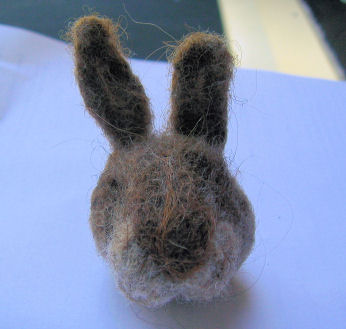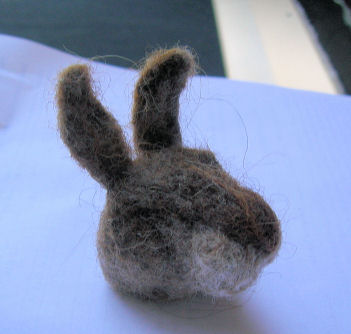For artists and collectors sponsored by Intercal...your mohair supplier and Johnna's Mohair Store
 OK, all you expert needlefelters . . .
OK, all you expert needlefelters . . .
I'm trying to make a rabbit with a combination of sheep wool, mohair, roving (coarse), and merino.
The problem is that although the finer fibers do felt, I can't get them to turn hard and solid. They're not coming apart, but whatever I do those parts stay soft.
What am I doing wrong?
Is it possible that over-vigorous felting chops up the fibers too much?
It sound to me like you are not done felting. It takes a long time to make it hard. I add layers at a time and felt and then add more to make sure the center gets hard. Just keep going and see if it gets firmer, maybe just keep felting one small area and see if it hardens up. Make sure the needle you are using is not to fine. For large areas I use a coarse needle or a star needle. The felting goes a bit faster
Joanne
 Thanks, Joanne--I knew I could find help here.
Thanks, Joanne--I knew I could find help here.
I think you were absolutely right. I wasn't using enough fiber, or felting long enough when attaching the finer stuff to the already hardened stuff.
IT's working, but I need to heal a few wounds before having another go . . .
you mentioned quite a few fibres Eileen. Merino for a start won't felt hard so get rid of him.Its only good as an over-lay and as cotton tails Do some sample felting with the fibres individually. Find which ones felt really hard fast. Felting is a QUICK process. If it takes to long ditch it. Its the sculpting where the time gets used up. Not the initial prep work.
Wendy
LOL - I find this as a very funny juxtaposition - that both Judi & my banners appear at the bottom of this thread just now because both of us work to a very firm degree of needling.
There is a time and place for every style and degree of needling, but for most work, a very firm base or core is always best, no matter how firm of soft the surface is.
If the inside isn't firm the integrity of the whole piece is compromised: it needs a good firm core to hold together!
Yes, there are some fibers that are more difficult to needle firmly: did you personally blend these different breeds together or purchase them this way?
As with the listing of food ingredients on a pkg, the listing is in order of percentages (if you have actually the fiber) with an anonymous breed of 'Sheep's wool' listed first and Merino listed last.
I would guess that Merino is a very small percentage of the entire amount.
'Most' mohair is very glossy and has differing amount of wave (like crimp or curl in other breeds) in different animals but does needle well.
The word 'roving' doesn't give enough information as to what is in it.
And are the fibers truly, totally blended together or are you adding different fibers in different areas or layers for different effects?
'Coarse' as well could mean many things: Romney is an excellent needling fiber but is 'coarse compared to Merino but Fine compared to Churro/Navajo.
I personally would not chose either Merino or Churro/Navajo to needle with!
You also didn't say which needle(s) you were using and what size your project is (tall/wide), as well as how you were creating your piece (rolling the sections up? - like logs and needling them to form the base shapes) - as you can see, besides the amount of time spent needling, there are many other variables that affect how your project is turning out. If you describe how you started and how you are working along on it, including some of the particulars that I touched on, then we can give more specific guidelines to reach what you want your project to be!
As to over-vigorous needling & fibers breaking - the only time that I've known fibers to actually be broken or cut is when they are brought to a very firmly needled stage - they are stretched out as far as they can get within a structure and a needle of the larger sizes 32/36/38 is pushed in. There would be quite a bit of resistance felt ad these needles have barbs in relation to their diameter - a larger size than those on 40 & 42. These needles can and will break/cut fiber, but you will already have reached the very very firm stage and KNOW that no more needling is needed!
felting long enough when attaching the finer stuff to the already hardened stuff.
Also, the core or under layers are never completely needled hard or smooth before adding more fibers. That would not allow a good bond between previous and new fibers. Just as when applying new paint over old or other surface applications - the previous surfaces need to be roughened up or somewhat loose and able to grab the new fibers.
So never make the surface of the work a 'hardened' or firmly needled one, until there is no more fiber to be added.
This may not be needed info for you, Eileen, but I just wanted to add it, to clarify the use of the word hardened.


 Thanks, everyone--great information!
Thanks, everyone--great information!
Bobbi, my fiber stash is a combination of prepared hanks of coarse wool that was sold to me as "roving" (it feels like overprocessed hair) and several tagged fleeces I bought on eBay and washed myself. These include mohair, merino, alpaca, and romney.
I really don't care for the coarse wool "roving," but it could be good for cores.
I love the mohair--the range of natural colors in each fleece is beautiful.
After a few false starts, I've produced a 1.25" rabbit head using 36/38 S and T needles, so it still looks rough.
My first attempt had a solid core, but a squashy outer later. I still can't figure out how I managed this.
As for my method, such as it is, I started with small bits of fiber crossed at right angles, felted with coarse needles, folded, then increased with more pads of fibers at crossed angles. I'm trying to create the basic shapes and color blocks at this point--it seems to be holding its shape this time.
For the final layers, I'd like to keep the fibers in a more natural direction, nose to ear. Is this a function of felting? Bushing?
I'm e you later today after a Dr appt and work-out...